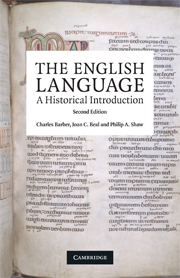Book contents
- Frontmatter
- Contents
- List of figures
- Preface to the second edition
- Preface to the first edition
- Map showing the counties of England
- 1 What is language?
- 2 The flux of language
- 3 The Indo-European languages
- 4 The Germanic languages
- 5 Old English
- 6 Norsemen and Normans
- 7 Middle English
- 8 Early Modern English
- 9 Late Modern English
- 10 English as a world language
- 11 English today and tomorrow
- Notes and suggestions for further reading
- Bibliography
- Index
4 - The Germanic languages
- Frontmatter
- Contents
- List of figures
- Preface to the second edition
- Preface to the first edition
- Map showing the counties of England
- 1 What is language?
- 2 The flux of language
- 3 The Indo-European languages
- 4 The Germanic languages
- 5 Old English
- 6 Norsemen and Normans
- 7 Middle English
- 8 Early Modern English
- 9 Late Modern English
- 10 English as a world language
- 11 English today and tomorrow
- Notes and suggestions for further reading
- Bibliography
- Index
Summary
The branch of Indo-European that English belongs to is called Germanic, and includes German, Dutch, Frisian, Danish, Swedish and Norwegian. All these languages are descended from one parent language, a dialect of Indo-European, which we can call Proto-Germanic (PG). Round about the beginning of the Christian era, the speakers of Proto-Germanic still formed a relatively homogeneous cultural and linguistic set of groups, living in the north of Europe. We have no records of the language in this period, but we know something about the people who spoke it, because they are described by Roman authors, who called them the Germani. One of the best-known of these descriptions is that written by Tacitus in AD 98, called Germania.
Early Germanic society
Tacitus describes the Germani as living in scattered settlements in the woody and marshy country of north-western Europe. He says that they do not build cities and keep their houses far apart, living in wooden buildings. They keep flocks, and grow grain crops, but their agriculture is not very advanced, and they do not practise horticulture. Because of the large amount of open ground, they change their ploughlands yearly, allotting areas to whole villages, and distributing land to cultivators in order of rank. The family plays a large part in their social organization, and the more relatives a man has the greater is his influence in his old age.
- Type
- Chapter
- Information
- The English LanguageA Historical Introduction, pp. 85 - 104Publisher: Cambridge University PressPrint publication year: 2009

